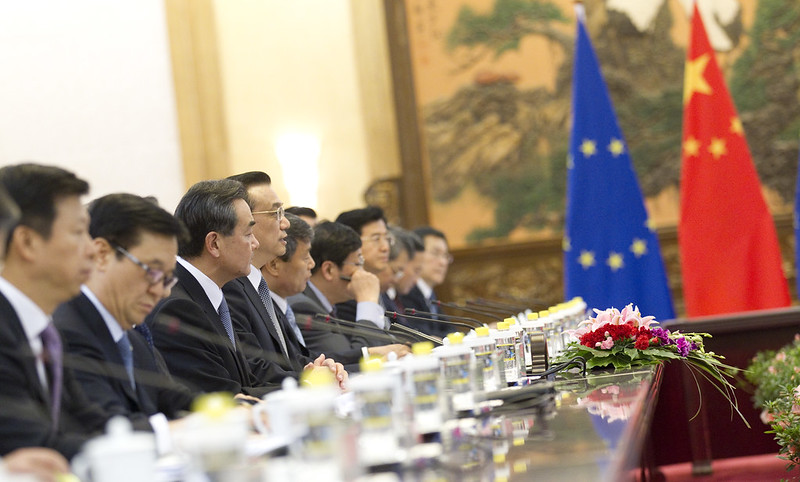
In mid-December 2018, China released its third document on the EU. The timing of its publication and willingness to deepen cooperation show, that China wants to improve relations with the EU in the midst of its disputes with the U.S., which have had a negative impact on China’s economy and international image. Chinese authorities hope that the EU will not use Trump’s methods, despite sharing some of his concerns. China instead expects the EU to continue its policy of engagement. However, the content of the document, essentially a long list of EU obligations and a wide catalogue of cooperation areas (such as 5G or high-tech) without reference to the EU’s concerns, calls its usefulness into question.
China first published a document concerning the EU in 2003, when bilateral relations were elevated to a strategic partnership. The second version was announced after Xi Jinping’s visit to Brussels in 2014. The rationale for the third edition, released on 18 December 2018, was the twin anniversaries of 20 years of EU-China summits and 15 years of the strategic partnership. The main content of the third document was in the 2014 edition. However, the hierarchy of arguments and the timing of the document’s publication reveal China’s motivations for issuing the third paper.
The first rationale is dissatisfaction with EU and Member State policies that criticise China for its foreign economic policy (e.g., attempts to acquire high-tech through investments) and the worsening human-rights situation. The second rationale is to highlight China’s pro-EU policy vis-à-vis the disputes with the U.S. Therefore, the document is inherently inconsistent. It begins by highlighting that the EU is the most integrated institution in the world and an important element of the multilateral order. However, the main part of the document contains a long list of Chinese requirements (“obligations”) and a wish list of cooperation areas.
What the EU Should Do
The first group of claims concern respect for China’s “core interests.” These are related to sovereignty and territorial integrity—issues that China views as non-negotiable. The EU and its Member States should oppose any form of independence for Taiwan, not maintain any official relations with it, not sign any agreements, not support its membership in organisations that require sovereign state membership, not cooperate military, etc. This may be referencing the EU-Taiwan economic consultations held in Brussels in December. On Tibet, China states the EU should not allow visits by the Dalai Lama, whose purpose, according to the document, is to undermine China’s integrity.
The EU should also not support an independent “Eastern Turkestan,” or acts of terrorism and religious extremism. It seems the latter demands might be a reaction to the criticism expressed by the EU and some countries (e.g., Germany) about Chinese repression of Uyghurs in Xinjiang. The EU should also not interfere in Macau or in Hong Kong, which are part of China under the “one country, two systems” principle. This is probably a response to criticism voiced by the UK about the deterioration of human rights and rule of law in Hong Kong as well as Sweden’s demand to release an imprisoned Hong Kong bookseller who is also a Swedish citizen.
The second group in the document comprises a catalogue of “obligations” related to economic cooperation, security, and human rights. The EU should not apply what China considers double standards in counter-terrorism cooperation. This is a supposed attempt to put pressure on the EU to consider Uyghurs as terrorists and the Chinese authorities’ actions as fighting terrorism. China also demands the EU lift the arms embargo on it as soon as possible.
On economic issues, the EU should not “politicise” trade—a signal not to support Trump’s actions. The EU should also ease restrictions on the export of innovations to China, maintain an open-investment market, and adhere to WTO rules. These arguments are responses to EU actions such as adopting an investment-screening mechanism and proposals for WTO reform. The EU should also “objectively assess the human-rights situation in China,” which is shorthand for not interfering in China’s internal affairs.
Cooperation Wish List
The document contains a wide catalogue of cooperation areas, however, recent EU concerns and problems in bilateral relations are not mentioned. China wants to cooperate in the field of security. It proposes anti-terrorism, extradition, and police cooperation in combating cross-border crime. Yet, there is no mention about China’s controversial demands for the extradition of Uyghurs—accused by the Chinese authorities of terrorism—or Taiwanese suspected of other crimes, or Europe’s concerns about the recent detentions of foreigners in China in response to the arrest in Canada of Huawei’s deputy director.
China also proposes cooperation in new technologies, including 5G, artificial intelligence and smart cities. China also suggests working jointly on problems related to high-tech. For example, China suggests cooperation on data protection. There is no mention of the growing concerns outside China about Huawei’s actions (expressed recently by the Czech Republic, UK, and Poland, among others) or Chinese investments in EU high-tech enterprises. There are also no references to the concern about testing (especially in Xinjiang) techniques for citizen control, including facial-recognition systems.
The economy is another area of cooperation. China proposed a free-trade agreement (FTA) feasibility study, but the EU has not signalled the possibility to launch negotiations (for the EU, the priority is the investment agreement negotiated since 2014). There are also doubts about cooperation in the energy sector, considered in the EU to be critical infrastructure. China argues that it is opening its market, with “negative lists” as its best evidence. It also suggests joint reform of the international financial system as well as the WTO.
China wants to develop people-to-people contacts as well. For example, it proposes setting up cultural centres. However, the document does not address the concerns in the EU related to the activities of Confucius Institutes, including cases where these institutions were closed, such as in Sweden. China proposes media cooperation and fighting “fake news.” At the same time, there is no mention about doubts related to China’s alleged misuse of social media and modern technologies to interfere in elections—Taiwan—or hacker attacks and cyberespionage, which were expressed most recently by Poland.
Perspectives
China wants to cooperate with the EU on its own terms on the basis of its own uncompromising vision of those relations. The document is an attempt to reconcile conflicting Chinese interests. It is not an expression of Chinese diplomatic weakness. For internal use, it shows China as being tough.
The list of EU “obligations” is a response to the EU’s more cautious and critical approach towards China, such as protective measures. They include, the investment-screening mechanism, the EU strategy on connectivity in response to Chinese activity under its Belt and Road Initiative, as well as more vocal critics of China’s treatment of human rights. But the main goal is to find allies in the EU in the face of growing fears of the China’s global activities, which have a negative impact on China’s economy. The list of cooperation areas are arguments that can be used by the EU Member States who pursue more favourable policies towards China, such as Hungary or Portugal.
The Chinese authorities are aware that the EU shares the U.S.’s diagnosis about the failure of the engagement policy. It has not resulted in the liberalisation of China’s political and economic systems, as state capitalism and centralisation of power is increasing. Nevertheless, the EU does not want to use Trump’s methods of de-coupling from China, rather preferring to pursue a policy that could be called “cautious engagement.” China is also trying to play on the friction in transatlantic relations (e.g., WTO issues, the nuclear deal with Iran, or President Trump’s criticism of the EU and some of its Member States). Chinese authorities are sending positive signals to some countries, for example, to Germany, giving it wider access to the Chinese market, or downgrading the significance of the 16+1 formula.
In the coming months, one may expect stagnation in EU-China relations. However, a possible failure in the U.S.-China talks on a trade-war “ceasefire” may increase the possibility of a China-U.S. rivalry in Europe, including in Central Europe. It is in Poland’s interest to strengthen the consensus around EU-China policy, which is now less confrontational than the U.S. actions. Poland, under the framework of the verification of results of the strategic partnership with China, should lean towards the EU’s policy of cautious engagement.
The article was originally published by PISM.
Written by
Justyna Szczudlik
ShilinabolanJustyna Szczudlik is the deputy head of research, a China analyst, and the former Head of Asia-Pacific Program (2016-2021) with the Polish Institute of International Affairs (PISM).

